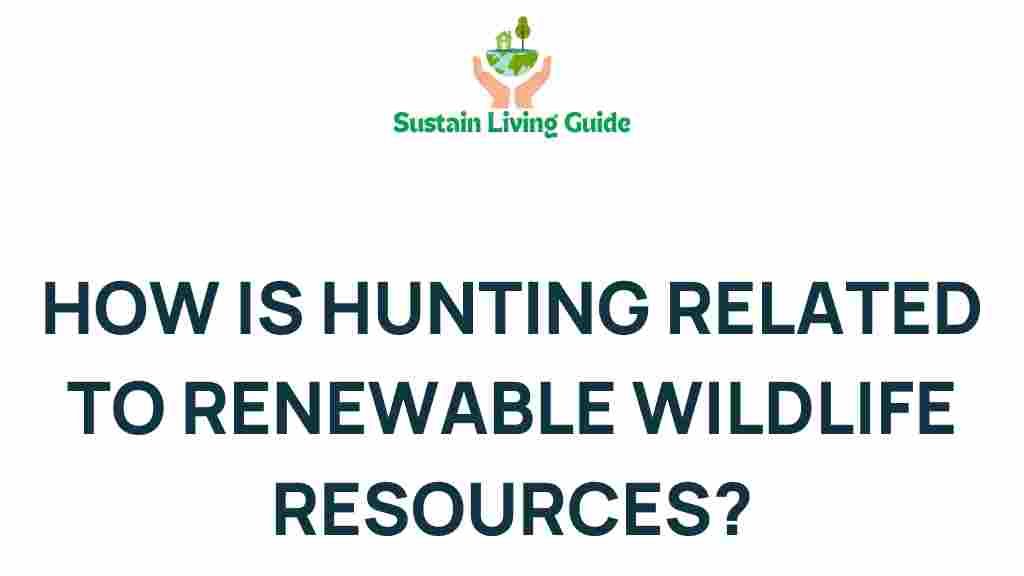Unveiling the Connection: How Hunting Supports Renewable Wildlife Resources
Hunting is often a controversial topic, sparking debates about ethics, conservation, and wildlife management. However, what many might not realize is the significant role hunting plays in supporting renewable wildlife resources. It is essential to delve into the intricate relationship between hunting and wildlife conservation to understand how regulated hunting can contribute to the sustainability of ecosystems and biodiversity. This article will explore various aspects of hunting and its positive impacts on wildlife resources, conservation efforts, and the economy.
The Role of Hunting in Conservation
Hunting, when conducted responsibly and within regulatory frameworks, serves as a vital tool for conservation. The concept of sustainable hunting focuses on maintaining wildlife populations at healthy levels while allowing for the responsible harvest of animals. Here are some key points illustrating this connection:
- Population Control: Hunting helps manage animal populations that may otherwise grow unchecked, leading to overpopulation. Overpopulation can result in habitat destruction and increased human-wildlife conflicts.
- Funding for Conservation: License fees and taxes on hunting equipment contribute significantly to wildlife conservation programs. In the United States, the Pittman-Robertson Act directs funds from hunting-related activities to wildlife management and conservation.
- Habitat Preservation: Many hunting organizations actively engage in habitat restoration and preservation projects, ensuring that ecosystems remain healthy and vibrant.
How Hunting Supports Renewable Wildlife Resources
Understanding how hunting supports renewable wildlife resources requires a closer look at the mechanisms in place that facilitate this relationship. Here is a step-by-step process explaining how hunting contributes to wildlife conservation:
Step 1: Regulatory Frameworks
Responsible hunting is governed by strict regulations that include:
- Seasonal Restrictions: Hunting seasons are established to coincide with animal breeding patterns, ensuring that populations are not depleted during critical periods.
- Quota Systems: Wildlife management authorities set quotas for the number of animals that can be harvested each season, ensuring populations are maintained at sustainable levels.
Step 2: Data Collection and Research
Hunting provides vital data that aids in wildlife research, including:
- Population Surveys: Hunters contribute to population monitoring by reporting their harvests, which helps biologists assess wildlife numbers.
- Health Assessments: Examining harvested animals can provide insights into the health of populations and ecosystems.
Step 3: Community Engagement
Hunting fosters a sense of community and shared responsibility among hunters, leading to:
- Education and Awareness: Hunters often become advocates for wildlife conservation, promoting sustainable practices within their communities.
- Volunteer Initiatives: Many hunting organizations engage in volunteer conservation projects, such as habitat restoration and clean-up efforts.
Economic Benefits of Hunting
The economic impact of hunting extends beyond individual hunters. It encompasses entire communities and contributes to the broader economy. Key economic benefits include:
- Job Creation: The hunting industry supports jobs in various sectors, including tourism, retail, and conservation organizations.
- Local Economies: Hunting tourism brings revenue to local communities, benefiting businesses such as hotels, restaurants, and guides.
- Investment in Conservation: The funds generated through hunting activities are often reinvested in wildlife conservation and habitat preservation efforts.
Addressing Common Misconceptions
Despite the positive aspects of hunting, misconceptions persist. Here are some common myths debunked:
- Myth 1: Hunting is detrimental to wildlife populations. While unregulated hunting can harm populations, responsible hunting contributes to population management and conservation.
- Myth 2: All hunters are irresponsible. The majority of hunters prioritize conservation and adhere to ethical practices.
- Myth 3: Hunting is purely for sport. Many hunters engage in hunting for food, supporting local and sustainable food systems.
Troubleshooting Tips for Ethical Hunting Practices
To ensure that hunting remains a sustainable practice, hunters should consider the following tips:
- Stay Informed: Keep up-to-date with local regulations and wildlife management practices.
- Practice Ethical Hunting: Only hunt within legal limits and respect wildlife habitats.
- Participate in Conservation Programs: Join local conservation groups to support habitat preservation initiatives.
Conclusion: The Future of Hunting and Conservation
In conclusion, hunting plays an integral role in supporting renewable wildlife resources. By adhering to responsible practices, hunters contribute significantly to wildlife conservation, habitat preservation, and local economies. As we look towards the future, it is essential to foster a deeper understanding of the positive impacts of hunting and promote collaboration between hunters, conservationists, and policymakers.
For more information on hunting regulations and conservation efforts, you can visit this resource. If you are interested in joining a local conservation group, check out these organizations dedicated to preserving wildlife and their habitats.
This article is in the category Eco-friendly and created by SustainLivingGuide Team

4 thoughts on “Unveiling the Connection: How Hunting Supports Renewable Wildlife Resources”